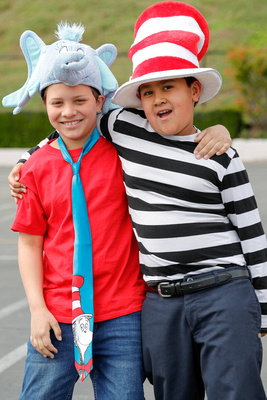Today we celebrate the birthday of Dr. Seuss (Theodor Seuss “Ted” Geisel), who wrote and illustrated over 60 books. More than 600 million copies of his 43 children’s books have been sold across the globe. Today, our North Campus students are remembering this beloved author by dressing up in character and sharing their favorite Seuss stories.
Dr. Seuss encouraged a love of reading (“The more that you read, the more things you will know…”). His first book, published in 1936, was written in an age before television and computers, when children spent their free time exploring nature and getting much needed fresh air and sunshine. Eighty-four years later, technology has changed the world, and the learning Dr. Seuss envisioned has increased exponentially.
Along with these great advances in learning technologies, however, we are beginning to recognize some detrimental effects. Because of the time most children and adults spend in near work activities (watching television, using a computer screen, texting or taking pictures with a cell phone, as well as reading and writing), ophthalmologists are seeing a substantial increase in children who exhibit vision problems. Myopia, also known as nearsightedness, has nearly doubled in the United States, rising from 25% to 41% since the 1970s. Computer Vision Syndrome (CVS) may lead to problems such as headaches, eye strain, blurred vision, dry eyes, or neck and shoulder pain. These symptoms are generally temporary, but they increase as screen time increases, and most children and adults spend anywhere from 4-8 hours in front of a digital screen every day.
The American Academy of Ophthalmology (AAO) suggests that the progression of nearsightedness can be slowed in children if they spend more time outdoors and away from screens. Other suggestions include taking a 20 second break from near work every 20 minutes by looking up and out the window. Paper clipping a book every two chapters is a good way to remind children it’s time for a break. Similarly, looking up and out after completing a level in a video game is effective, and taking quick breaks from TV time is important as well. A few other suggestions include the use of good posture when using a computer or reading, holding digital media further away (18 – 24” is recommended), and reminding children to blink (we don’t blink as often when using digital devices), all of which may alleviate vision problems.
At St. Michael’s School, children have the opportunity to enjoy the outdoors and sunshine pretty regularly throughout the day. On South Campus, students have a five-minute passing period between classes; students on both campuses trek back and forth to music, art, the computer lab, library, and the church, and all students are outside for PE, recess, and lunch. Teachers, however, will begin being mindful of the 20 minute rule during near work activities, and remind students to look up and out to give their eyes a 20 second break.
As with anything, we should strive for balance. Reading, writing, and technology are all valuable and necessary in our culture today, but there also may be value in the practices of the past. Below is an excerpt from educator and philosopher Maria Montessori who speaks to this topic:
“Let the children be free; encourage them;
let them run outside when it is raining;
let them remove their shoes when they find a puddle of water;
and when the grass of the meadows is wet with dew,
let them run on it and trample it with their bare feet;
let them rest peacefully when a tree invites them to sleep beneath its shade;
let them shout and laugh when the sun wakes them in the morning.”
~ Maria Montessori
Happy Birthday Dr. Seuss, and thank you for your wisdom, wit, and fun. “You’re off to great places. Today is your day! Your mountain is waiting, so…get on your way!”
References:
“Is Too Much Screen-time Harming Children’s Vision?”
American Academy of Ophthalmology
August 6, 2018
“Is Studying Destroying Your Vision?”
USA Today
May 7, 2012




